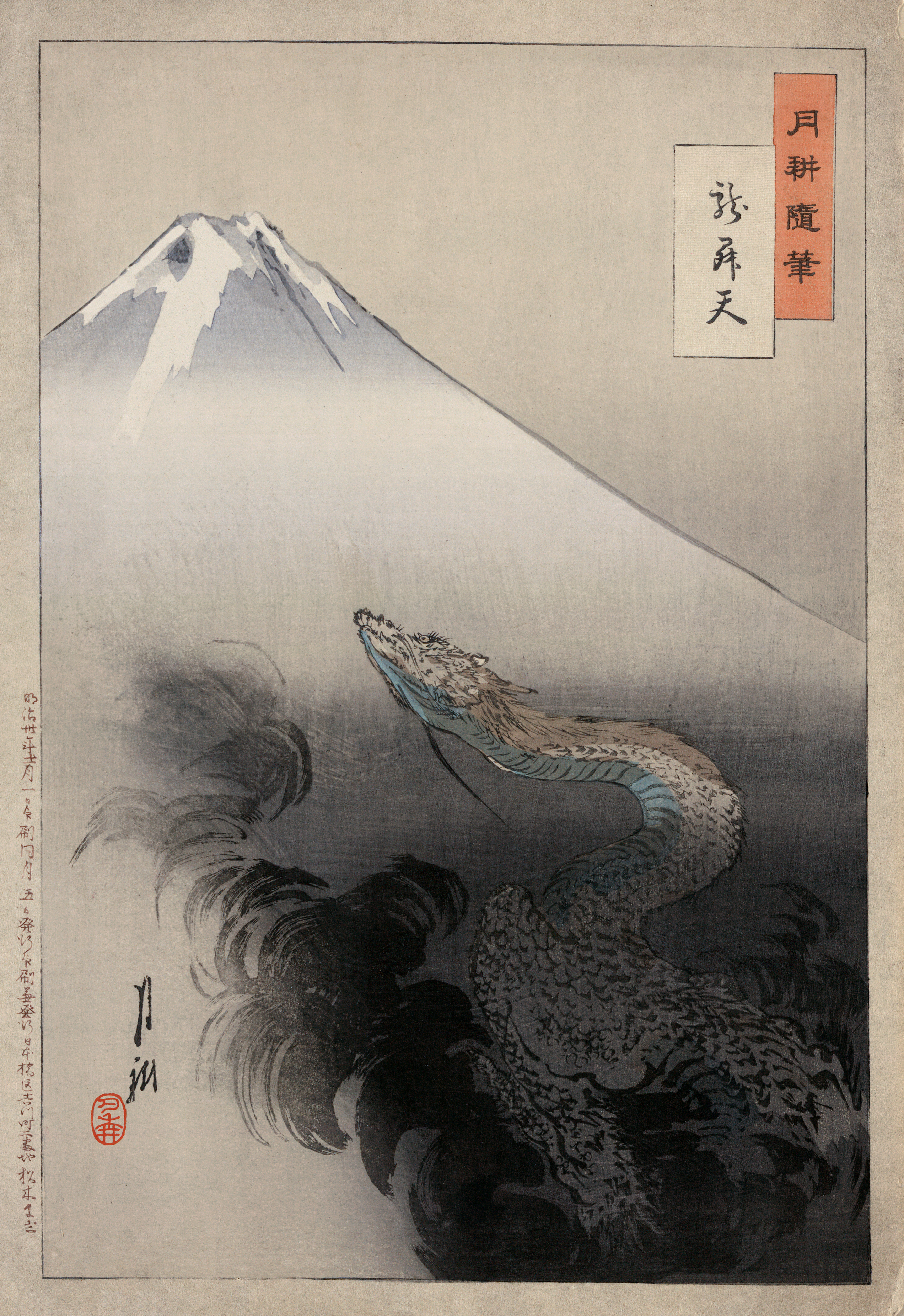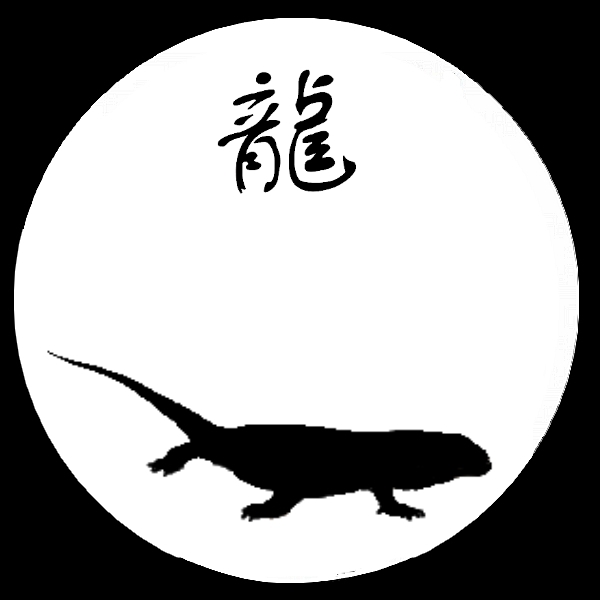|
ķŠŹ
Radical 212, ķŠŹ, ķŠÖ, or ń½£ meaning "dragon", is one of the two of the 214 Kangxi radicals that are composed of 16 strokes. The character arose as a stylized drawing of a Chinese dragon,ķŠŹ: bottom left: jaws (open downwards); top left: back of head; right side: body and legs; right bottommost stroke: tail and refers to a version of the dragon in each East Asian culture: *Chinese dragon, ''L├│ng'' in Chinese * Japanese dragon, ''Ry┼½'' or ''Tatsu'' in Japanese *Korean dragon, ''Ryong'' or ''Yong'' in Korean * Vietnamese dragon, ''Rß╗ōng'' in Vietnamese It may also refer to the Dragon as it appears in the Chinese zodiac. It is used as the symbol for Tatsu, a roller coaster at Six Flags Magic Mountain, in California. In the Kangxi Dictionary 14 characters (out of 40,000) are under this radical. It occurs as a phonetic complement in some fairly common Chinese characters, for example ĶüŠ = " deaf", which is composed of ķŠŹ "dragon" and the " ear" ĶĆ│ radical, "a word with mea ... [...More Info...] [...Related Items...] OR: [Wikipedia] [Google] [Baidu] |
Chinese Dragon
The Chinese dragon, also known as ''loong'', ''long'' or ''lung'', is a legendary creature in Chinese mythology, Chinese folklore, and Chinese culture at large. Chinese dragons have many Outline of life forms, animal-like forms such as Bixi (mythology), turtles and Chiwen, fish, but are most commonly depicted as snake-like with four legs. Academicians have identified four reliable theories on the origin of the Chinese dragon: snakes, Chinese alligators, thunder and nature worship. They traditionally symbolize potent and wikt:auspicious, auspicious powers, particularly control over water, rainfall, typhoons, and floods. The dragon is also a symbol of power, strength, and good luck for people who are worthy of it in East Asian cultural sphere, East Asian culture. During the days of Imperial China, the Emperor of China usually used the dragon as a symbol of his imperial strength and power. In Chinese culture, excellent and outstanding people are compared to a dragon, while incapable ... [...More Info...] [...Related Items...] OR: [Wikipedia] [Google] [Baidu] |
Japanese Dragon
Japanese dragons (, ''Nihon no ry┼½'') are diverse legendary creatures in Japanese mythology and folklore. Japanese dragon myths amalgamate native legends with imported stories about dragons from China, Korea and the Indian subcontinent. The style and appearance of the dragon was heavily influenced by the Chinese dragon, especially the three-clawed ''long'' (ķŠŹ) dragons which were introduced in Japan from China in ancient times. Like these other East Asian dragons, most Japanese ones are water deities associated with rainfall and bodies of water, and are typically depicted as large, wingless, serpentine creatures with clawed feet. Indigenous Japanese dragons The c. 680 AD ''Kojiki'' and the c. 720 AD '' Nihongi'' mytho-histories have the first Japanese textual references to dragons. "In the oldest annals the dragons are mentioned in various ways," explains de Visser, "but mostly as water-gods, serpent- or dragon-shaped." The ''Kojiki'' and ''Nihongi'' mention several a ... [...More Info...] [...Related Items...] OR: [Wikipedia] [Google] [Baidu] |
Korean Dragon
Korean dragons are legendary creatures in Korean mythology and folklore. The appearance of the dragon reflects its relation to its East Asian counterparts, including the Chinese dragons. Korean dragons Whereas most dragons in European mythology are linked to the elements of fire and destruction, dragons in Korean mythology are primarily benevolent beings related to water and agriculture, often considered bringers of rain and clouds. Hence, many Korean dragons are said to have resided in rivers, lakes, oceans, or even deep mountain ponds. The symbol of the dragon has been used extensively in Korean culture, both in Korean mythology and ancient Korean art. Ancient texts sometimes mention sentient ''speaking'' dragons, capable of understanding complex emotions such as devotion, kindness, and gratitude. One particular Korean legend speaks of the great King Munmu, who on his deathbed wished to become a " Dragon of the East Sea in order to protect Korea". The Korean dragon is in many ... [...More Info...] [...Related Items...] OR: [Wikipedia] [Google] [Baidu] |
Dragon (zodiac)
The Dragon, also known as Loong, () is the fifth of the 12-year cycle of animals which appear in the Chinese zodiac related to the Chinese calendar. The Year of the Dragon is associated with the Earthly Branch symbol ĶŠ░, pronounced ''chen''. It has been proposed by one academic researcher that the Earthly Branch character may have been associated with scorpions; it may have symbolized the star Antares. In the Buddhist calendar used in Thailand, Cambodia, Laos, Myanmar, and Sri Lanka, the Dragon is replaced by the n─üga. In the Gurung zodiac, the Dragon is replaced by the eagle. In Old Turkic calendar it is replaced by the fish or crocodile. Early Persian translations of the medieval period change to dragon to a sea serpent although in current times is generally refer to as whale. During the Cultural Revolution, giant panda was situated in the place of the dragon although this didn't last long. Years and the Five Elements People born within these date ranges can be said to ha ... [...More Info...] [...Related Items...] OR: [Wikipedia] [Google] [Baidu] |
Dragon
A dragon is a reptilian legendary creature that appears in the folklore of many cultures worldwide. Beliefs about dragons vary considerably through regions, but dragons in western cultures since the High Middle Ages have often been depicted as winged, horned, and capable of breathing fire. Dragons in eastern cultures are usually depicted as wingless, four-legged, serpentine creatures with above-average intelligence. Commonalities between dragons' traits are often a hybridization of feline, reptilian and avian features. Scholars believe huge extinct or migrating crocodiles bear the closest resemblance, especially when encountered in forested or swampy areas, and are most likely the template of modern Oriental dragon imagery. Etymology The word ''dragon'' entered the English language in the early 13th century from Old French ''dragon'', which in turn comes from la, draconem (nominative ) meaning "huge serpent, dragon", from Ancient Greek , (genitive , ) "serpent, giant s ... [...More Info...] [...Related Items...] OR: [Wikipedia] [Google] [Baidu] |
Vietnamese Dragon
Vietnamese dragons ( vi, Rß╗ōng; ; Sino-Vietnamese: ''Long''; ) are symbolic creatures in Vietnamese folklore and mythology. According to an ancient origin myth, the Vietnamese people are descended from a dragon and a fairy. The dragon was symbolic of bringing rain, essential for agriculture. It represents the emperor, the prosperity and power of the nation. Similar to the Chinese dragon (which has also influenced and appeared in Japan and Korea as fierce but benevolent serpentine dragons alike), the Vietnamese dragon is the symbol of yang, representing the universe, life, existence, and growth. The creation legend Lß║Īc Long Qu├ón, king of the dragonkind living near the ─É├┤ng sea, married a fairy goddess, ├éu CŲĪ who was the daughter of the birdkind emperor ─Éß║┐ Lai, descendant of Thß║¦n N├┤ng. ├éu CŲĪ bore 100 eggs, which hatched into 100 sons. The first-born son became the king of Lß║Īc Viß╗ćt, the first dynasty of Vietnam, and proclaimed himself Emperor H├╣ng VŲ░ŲĪng. ... [...More Info...] [...Related Items...] OR: [Wikipedia] [Google] [Baidu] |
Chinese Zodiac
The Chinese zodiac is a traditional classification scheme based on the lunar calendar that assigns an animal and its reputed attributes to each year in a repeating twelve-year cycle. Originating from China, the zodiac and its variations remain popular in many East Asian and Southeast Asian countries, such as Japan, South Korea, Vietnam, Singapore, Nepal, Bhutan and Thailand. Identifying this scheme using the generic term "''zodiac''" reflects several superficial similarities to the Western zodiac: both have time cycles divided into twelve parts, each labels at least the majority of those parts with names of animals, and each is widely associated with a culture of ascribing a person's personality or events in their life to the supposed influence of the person's particular relationship to the cycle. Nevertheless, there are major differences between the two: the animals of the Chinese zodiac are not associated with constellations spanned by the ecliptic plane. The Chinese twelve- ... [...More Info...] [...Related Items...] OR: [Wikipedia] [Google] [Baidu] |
Kangxi Radical
The 214 Kangxi radicals (), also known as the Zihui radicals, form a system of radicals () of Chinese characters. The radicals are numbered in stroke count order. They are the most popular system of radicals for dictionaries that order Traditional Chinese characters (''hanzi'', ''hanja'', ''kanji'', ''chß╗» h├Īn'') by radical and stroke count. They are officially part of the Unicode encoding system for CJKV characters, in their standard order, under the coding block "Kangxi radicals", while their graphic variants are contained in the "CJK Radicals Supplement". Thus, a reference to "radical 61", for example, without additional context, refers to the 61st radical of the ''Kangxi Dictionary'', Õ┐ā; ''x─½n'' "heart". Originally introduced in the 1615 ''Zihui'' (ÕŁŚÕĮÖ), they are more commonly named in relation to the ''Kangxi Dictionary'' of 1716 ('' K─üngx─½'' being the era name for 1662ŌĆō1723). The 1915 encyclopedic word dictionary ''Ciyuan'' (ĶŠŁµ║É) also uses this syste ... [...More Info...] [...Related Items...] OR: [Wikipedia] [Google] [Baidu] |
Kangxi Dictionary
The ''Kangxi Dictionary'' ( (Compendium of standard characters from the Kangxi period), published in 1716, was the most authoritative dictionary of Chinese characters from the 18th century through the early 20th. The Kangxi Emperor of the Qing dynasty ordered its compilation in 1710 in order to improve on earlier dictionaries, to show his concern for Confucian culture, and to foster the standardization of the writing system. The dictionary takes its name from the Emperor's era name. The dictionary was the largest of the traditional dictionaries, containing 47,035 characters. Some 40% of them are graphic variants, however, while others are dead, archaic, or found only once. Fewer than a quarter of the characters it contains are now in common use. The ''Kangxi Dictionary'' is available in many forms, from Qing dynasty block print editions, to reprints in traditional Chinese bookbinding, to modern revised editions with essays in Western-style hardcover, to a digitized Internet ve ... [...More Info...] [...Related Items...] OR: [Wikipedia] [Google] [Baidu] |
Deaf
Deafness has varying definitions in cultural and medical contexts. In medical contexts, the meaning of deafness is hearing loss that precludes a person from understanding spoken language, an Audiology, audiological condition. In this context it is written with a lower case ''d''. It later came to be used in a cultural context to refer to those who primarily communicate through sign language regardless of hearing ability, often capitalized as ''Deaf'' and referred to as "big D Deaf" in speech and sign. The two definitions overlap but are not identical, as hearing loss includes cases that are not severe enough to impact spoken language comprehension, while cultural Deafness includes hearing people who use sign language, such as Child of deaf adult, children of deaf adults. Medical context In a medical context, deafness is defined as a degree of hearing difference such that a person is unable to understand speech, even in the presence of amplification. In profound deafness, e ... [...More Info...] [...Related Items...] OR: [Wikipedia] [Google] [Baidu] |
Phonetic Complement
A phonetic complement is a phonetic symbol used to disambiguate word characters (logograms) that have multiple readings, in mixed logographic-phonetic scripts such as Egyptian hieroglyphs, Akkadian cuneiform, Japanese, and Mayan. Often they reenforce the communication of the ideogram by repeating the first or last syllable in the term. Written English has few logograms, primarily numerals, and therefore few phonetic complements. An example is the ''nd'' of ''2nd'' 'second', which avoids ambiguity with 2 standing for the word 'two'. In addition to numerals, other examples include Xmas, Xianity, and Xing for Christmas, Christianity, and Crossing ŌĆō note the separate readings ''Christ'' and ''Cross''. In cuneiform In Sumerian, the single word ''kur'' had two meanings: 'hill' and 'country'. Akkadian, however, had separate words for these two meanings: ''┼Īad├║'' 'hill' and ''m─ütu'' 'country'. When Sumerian cuneiform was adapted for writing Akkadian, this was ambiguous because b ... [...More Info...] [...Related Items...] OR: [Wikipedia] [Google] [Baidu] |





